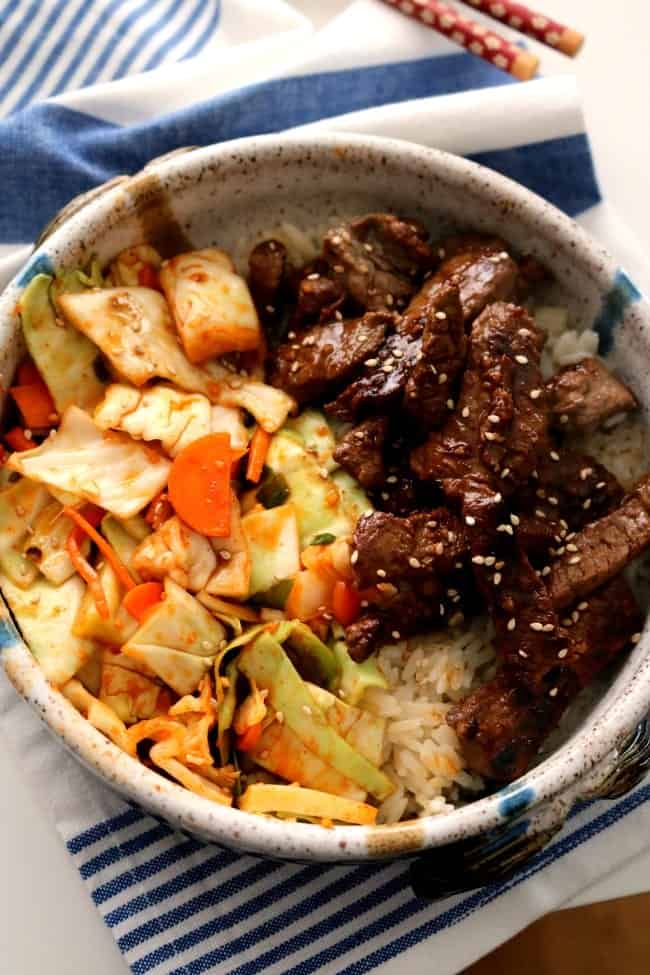Ready in as little as 15-minutes, this quick Korean kimchi is delicious unfermented but may be left to ferment as well. Starting with Korean Gochujang paste [paid link] and common green cabbage, this marinated kimchi is as quick as it is flavorful.
My husband and I love food and flavors from around the world. International flavors are really our “thing.” So, when our local grocery store started carrying Kimchi a few years ago, we immediately bought a jar to try. Before we knew it, it was gone.

The small jars of Kimchi in American grocery stores (and even our local Asian markets) are pretty pricey when you consider the size jar you purchase, so we set out to find out how to make our own.
So off to the internet I went to find some solid, authentic advice on making our own kimchi at home. I was elated to find Maangchi and her Emergency Kimchi on YouTube.

I know some people may be reluctant to try kimchi because they are afraid of the word “fermented.” However, you may already be familiar with and have probably eaten another widely popular fermented cabbage called sauerkraut. Yes, sauerkraut!
That’s right! Americans have been topping brats, hot dogs, burgers, and deli sandwiches for decades with a German-style fermented cabbage. Kimchi is just sauerkraut’s spicy cousin! Move over sauerkraut, there’s a new cabbage in town.

So what makes kimchi different than sauerkraut? The answer is gochujang.
Gochujang is a Korean hot red pepper paste that starts with a red hot chili powder. The dried peppers can range from mild to hot and so can the gochujang paste [paid link]. That’s why most tubs of gochujang paste [paid link] are labeled with a spice level. The package I purchased was labeled as a medium spice.
Gochujang is becoming more mainstream and can now even be found in some grocery stores and big-box stores, like Walmart. Of course, it’s also available online at Amazon or in most Asian markets.
Kitchen Notes:
-
To make a vegetarian kimchi, you can replace fish sauce with and an equal amount of soy sauce. Fish sauce has a unique flavor and aroma and lends an overall saltiness to the vegetables. If you chose to use soy sauce, especially a low sodium version, you may need to adjust the salt in the recipe.
-
Napa Cabbage and common green cabbage are interchangeable in this recipe. Napa cabbage is not readily available in all markets but is more traditional to kimchi.

Save this Quick {Unfermented} Korean Green Cabbage Kimchi to your “International,” “Sides,” “Vegetable,” or “Recipe” boards.
While we’re at it, let’s be friends on Pinterest! I’m always pinning great new content.

Quick {Unfermented} Korean Green Cabbage Kimchi: Yangbaechu Kimchi
Ingredients
- 2 lbs Napa or common green cabbage [See Note 1]
- 1/4 cup table salt
- 1 cup water
Kimichi Sauce:
- 1/3 cup gochujang [See Note 2]
- 1 tablespoon fish sauce , more or less to taste [See Note 3]
- 1 tablespoon sugar
- 1/4 cup garlic , minced
- 3-4 (about 1/3 cup) green onions (scallions), sliced
- 1/4 cup carrots , slices into half rounds or julienned
Instructions
- Cut 2 pounds of cabbage into bite-sized strips about 2-3 inches in length and ¼ inch wide. Place into a large bowl. Add 1 cup cold water and ¼ cup kosher salt. Mix well with your hands to properly salt the cabbage. Set aside for about 10 minutes.
- Meanwhile, prepare the kimichi sauce by mixing all of the ingredients in a bowl. Set aside
- After 10 minutes, the salted cabbage will have reduced by 1/4 to almost 1/2 its original volume.
- Wash and rinse the salted cabbage with cold water a couple of times. Drain the water before adding the kimchi sauce.
- Mix the kimchi paste into the cabbage thoroughly.
- Store the kimchi in a container, jar, or plastic bag. Press the top of the kimchi down with your hands to protect your kimchi from being exposed to too much air.
- You can eat it right away, just like salad. If you prefer, store the kimchi at room temperature and it will ferment in a few days.
- Both fresh and fermented kimchi can be used in many recipes, or as a side dish.
Notes
- Kimchi is usually made with Napa cabbage, however, Napa cabbage and common green cabbage are interchangeable in this recipe. Napa cababbge is not readily available in all markets.
- Gochujang is a korean hot red pepper paste that starts with a red hot chili powder.
- The dried peppers can range from mild to hot and so can the gochujang paste [paid link]. That's why most tubs of gochujang paste [paid link] are labeled with a spice level.
- The package I purchased was labelled as a medium spice. Gochujang is becoming more mainstream and can be found in some grocery stores and even big box stores, like Walmart.
- It is also available online at Amazon or in most Asian markets.
- To increase the spice level, add more Gochujang paste [paid link] to your kimchi mixture.
- To make a vegetarian kimchi, or to buy fewer specialty ingredients, you can replace fish sauce with and equal amount of soy sauce.
- Fish sauce has a unique flavor and aroma and lends an overall saltiness to the dish.
- If you chose to use soy sauce, especially a low sodium version, you may need to adjust the salt in the recipe.
- Add Fish Sauce to taste.
Nutrition

So excited. Just what I’m looking for. Get back taya!
Great quick kimchi. Im so afraid of trying to ferment something myself.
Wrong.. Gochugaru is to be used not gochujang.
Great page, thank you. I have been doing basically this for years and here in México we do not have those Korean chiis so I have always used chile de árbol but in lesser amounts. The results are just fine.
How much fish sauce do you add?
Hi Joy,
I’d start with a tablespoon and move on from there by taste. It can be very overpowering for some people – so it’s mostly added by your own palate. Hope this helps.
This was very good. Kimchi was always scary until you said I could make the same flavors and eat it fresh without fermenting.
I’ve always been nervous about kimchi but after you drew the comparison to sauerkraut it made me look at it a different way. This was spicy but so good. I used soy instead of fish sauce. Didn’t let it ferment and instead just ate it up in a couple of days.